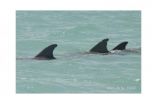(Press-News.org) Diving and plunging through the waves to feed, some whales throw their jaws wide and engulf colossal mouthfuls of fish-laden water while other species simply coast along with their mouths agape (ram or skim feeding), yet both feeding styles rely on a remarkable substance in the whales' mouths to filter nutrition from the ocean: baleen. Alexander Werth from Hampden-Sydney College, USA, explains that no one knew how the hairy substance actually traps morsels of food. 'The standard view was that baleen is just a static material and people had never thought of it moving or that its function would be altered by the flow of water through the mouth', he says. Werth became fascinated with the substance during his postdoc days, when he worked with the Inupiat Eskimos of Barrow, Alaska, and decided to find out more about how the flexible material filters whale-sized mouthfuls of water. He publishes his discovery that baleen is a highly mobile material that tangles in flowing water to form the perfect net for trapping food particles at natural whale swimming speeds in The Journal of Experimental Biology at http://jeb.biologists.org.
Explaining that baleen is composed of keratin – the same protein that makes hair and fingernails – Werth also describes how the protein forms large continually growing plates, each with an internal fibrous core sandwiched between smooth outer plates. Whales usually carry 300 of these structures on each side of their mouths – arranged perpendicular to the direction of water flowing into the mouth – and Werth explains that the plates are continually worn away by the tongue to form bristly food-trapping fringes on the tongue-edge of each plate. In addition, the baleen fringes of the skim-feeding bowhead whale's bristles are twice as long as the lunging humpback's. Having obtained baleen samples from the body of a stranded humpback during graduate work at the New England Aquarium and collected samples from ram-feeding bowheads in Alaska, Werth began to compare how well the baleen trapped minute latex beads carried in flowing water.
First, he tested a small section of each type of baleen in a flow tank as he varied the flow speed from 10 to 120 cm s and altered the inclination of the baleen to the water flow from parallel to perpendicular. Monitoring the fringes and recording how many beads became lodged for 2 s or more, Werth saw that the bristles trapped most beads at the lowest speeds, and as the flow increased the bristles began streaming like hair, increasing the fringe's porosity and reducing the number of snagged particles: single baleen plates are less effective filters at higher swimming speeds.
However, Werth says, 'It doesn't make sense to look at flow across a single plate of baleen, it's like looking at feeding with a single tooth; you can't chew anything with just one tooth, you need a whole mouthful.' So, he built a scaled down rack of six, 20 cm long baleen plate fragments and tested how well they trapped the latex beads.
This time, Werth could clearly see the fringes from adjacent baleen plates becoming tangled and more matted as the flow increased, trapping the most particles at speeds ranging from 70 to 80 cm/s, which corresponds exactly with the swimming speed of bowhead whales skimming through shoals of copepods. However, when he compared the porosity of the baleen of both species, he was surprised by the similarity of the performances, despite the whales' different feeding styles.
Having found that baleen filters best at the natural swimming speed of skim-feeding bowheads, Werth is keen to scale up and investigate how full-sized 4 m long baleen plates perform
###
IF REPORTING ON THIS STORY, PLEASE MENTION THE JOURNAL OF EXPERIMENTAL BIOLOGY AS THE SOURCE AND, IF REPORTING ONLINE, PLEASE CARRY A LINK TO: http://jeb.biologists.org/content/216/7/1152.abstract
REFERENCE: Werth, A. J. (2013). Flow-dependent porosity and other biomechanical properties of mysticete baleen. J. Exp. Bio. 216, 1152-1159.
This article is posted on this site to give advance access to other authorised media who may wish to report on this story. Full attribution is required, and if reporting online a link to jeb.biologists.com is also required. The story posted here is COPYRIGHTED. Therefore advance permission is required before any and every reproduction of each article in full. PLEASE CONTACT permissions@biologists.com
THIS ARTICLE IS EMBARGOED UNTIL WEDNESDAY, 13 March 2013, 18:00 HRS EDT (22:00 HRS GMT)
Whale's streaming baleen tangles to trap food
2013-03-14
ELSE PRESS RELEASES FROM THIS DATE:
Goats' milk with antimicrobial lysozyme speeds recovery from diarrhea
2013-03-14
Milk from goats that were genetically modified to produce higher levels of a human antimicrobial protein has proved effective in treating diarrhea in young pigs, demonstrating the potential for food products from transgenic animals to one day also benefit human health, report researchers at the University of California, Davis.
The study is the first on record to show that goats' milk carrying elevated levels of the antimicrobial lysozyme, a protein found in human breast milk, can successfully treat diarrhea caused by bacterial infection in the gastrointestinal tract.
The ...
Overheard phone calls more memorable, rated more distracting than other background talking
2013-03-14
A one-sided cellphone conversation in the background is likely to be much more distracting than overhearing a conversation between two people, according to research published March 13 in the open access journal PLOS ONE by Veronica Galván and colleagues from the University of San Diego.
The authors studied the effects of overhearing either one side of a cell phone call or a chat between two people on the attention and memory of people who overheard these conversations. Participants in the study were asked to complete a task involving anagrams. As they performed the task, ...
Bottlenose dolphin leaders more likely to lead relatives than unrelated individuals
2013-03-14
Traveling into uncharted territory in search of food can be a dangerous undertaking, but some bottlenose dolphins may benefit by moving through their habitat with relatives who may be more experienced or knowledgeable. It turns out that leaders in bottlenose dolphin groups in the Florida Keys are more likely to be related to the dolphins that follow them, according to research published March 13 by Jennifer Lewis and colleagues from Florida International University.
In complex habitats like the shallow waters of the Florida Keys, individuals who follow may benefit from ...
Study: Catheter-based varicose vein treatments more cost-effective
2013-03-14
DETROIT – Treating varicose veins with vein-stripping surgery is associated with higher costs than closing the veins with heat, according to a study at Henry Ford Hospital in Detroit.
"Cost-effectiveness is an important factor to consider when comparing different treatments for varicose vein disease," says Judith C. Lin, M.D., vascular surgeon and lead author of the study. "And these two types of treatment have similar effectiveness."
The study will be presented March 13 at the 41st Annual Symposium of the Society for Clinical Vascular Surgery in Miami.
The current ...
Implementing HPV vaccinations at a young age is significant for vaccine effectiveness
2013-03-14
Initial vaccinations for human papillomavirus (HPV) at a young age is important for maximizing quadrivalent HPV vaccine effectiveness according to a Swedish study published March 13 in the Journal of the National Cancer Institute.
HPV vaccination programs have been launched around the world in hopes of preventing cervical cancer and other HPV-related cancers. While incidence of genital warts is the earliest possible disease outcome to measure the efficacy of the HPV vaccine, the results of such efficacy trials may not be fully generalizable to real-life HPV vaccination ...
Protein may alter inevitability of osteoarthritis
2013-03-14
HOUSTON -- (March 13, 2013) – Few things in life are inevitable – death, taxes, and, if you live long enough, osteoarthritis.
No treatment will stop or significantly slow the disease, and joint replacement is the only definitive treatment. That may change, however, as researchers such as Dr. Brendan Lee (http://www.bcm.edu/genetics/index.cfm?pmid=10940), professor of molecular and human genetics at Baylor College of Medicine (http://www.bcm.edu), and his colleagues unravel the effects of a naturally occurring protein called lubricin or Proteoglycans 4 that appears to ...
Sex at zero gravity
2013-03-14
University of Montreal researchers found that changes in gravity affect the reproductive process in plants. Gravity modulates traffic on the intracellular "highways" that ensure the growth and functionality of the male reproductive organ in plants, the pollen tube. "Just like during human reproduction, the sperm cells in plants are delivered to the egg by a cylindrical tool. Unlike the delivery tool in animals, the device used during plant sex consists of a single cell, and only two sperm cells are discharged during each delivery event," explained Professor Anja Geitmann ...
Vitamin D supplements may help African Americans lower blood pressure
2013-03-14
Vitamin D supplements significantly reduced blood pressure in the first large controlled study of African-Americans, researchers report in the American Heart Association journal Hypertension.
In the prospective trial, a three-month regimen of daily vitamin D increased circulating blood levels of vitamin D and resulted in a decrease in systolic blood pressure ranging from .7 to four mmHg (depending upon the dose given), compared with no change in participants who received a placebo.
Systolic blood pressure, the top and highest number in a reading, is pressure in the arteries ...
Feynman's double-slit experiment brought to life
2013-03-14
The precise methodology of Richard Feynman's famous double-slit thought-experiment – a cornerstone of quantum mechanics that showed how electrons behave as both a particle and a wave – has been followed in full for the very first time.
Although the particle-wave duality of electrons has been demonstrated in a number of different ways since Feynman popularised the idea in 1965, none of the experiments have managed to fully replicate the methodology set out in Volume 3 of Feynman's famous Lectures on Physics.
"The technology to do this experiment has been around for about ...
No attention-boosting drugs for healthy kids, doctors urge
2013-03-14
Doctors at Yale School of Medicine and the American Academy of Neurology (AAN) have called upon their fellow physicians to limit or end the practice of prescribing memory-enhancing drugs to healthy children whose brains are still developing. Their position statement is published in the March 13 online issue of the journal Neurology, the medical journal of the AAN.
The statement was written to address the growing trend in which teens use "study drugs" before tests and parents request attention deficit hyperactivity disorder (ADHD) drugs for children who don't meet the ...

